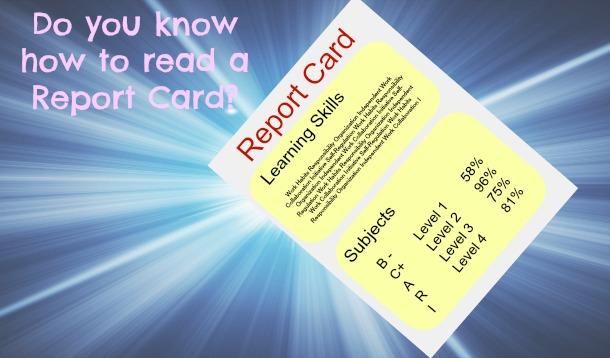
Report cards are coming home any day now. Teachers are busy putting the final touches on them, and in most schools, final printing will occur this week. Students will be carrying home these treasured or dreaded bits of paper next week. When your little scholar presents you this record of their achievement, will you know how to crack the teacher’s subtext to really understand how your student is doing?
![]() Get An A+ In Understanding Your Child's Assessments: The Rubric
Get An A+ In Understanding Your Child's Assessments: The Rubric
(all grades) | Letter Grades (Grade 1 -6) | Learning Skills (all grades) | Percentage Marks (grade 7-12) |
Level 4+ | A+ | E for excellent | 95-100 |
Level 4/4- | A/A- | E for excellent | 80-94 |
Level 3+ | B+ | G for good | 77-79 |
Level 3/3- | B/B- | G for good | 70-76 |
Level 2+ | C+ | S for satisfactory | 67-69 |
Level 2/2- | C/C- | S for satisfactory | 60-66 |
Level 1+ | D+ | N for Needs Improvement | 57-59 |
Level 1/1- | D/D- | N for Needs Improvement | 50-56 |
Remediation Required | R |
| Below 50 (R for Grade 7&8) |
Insufficient Evidence | I |
| Below 50 (R for Grade 7&8) |
Basically, teachers use a rubric for marking much of the student work and work habits, then the equivalent grades are determined. Marks equal to level four show that the student is surpassing what is excepted for their peer group across the province. Level threes mean your child meets the standard, so nothing to worry about here. Level twos are approaching the standard—the student may need a little more practice, repetition of information, or support from a teacher in order to successfully demonstrate their learning. Level ones mean that a student is falling significantly below the provincial standard—if your student's marks fall in these grade ranges, it is time to make a solid plan with the school to create greater success.
A code R (or marks below 50%) is what we would have called a "fail" in the olden days, when we still used such punitive phrases. It indicates the need for an intervention, such as developing an Individual Education Plan or support from Special Education. If a student is on an Individual Education Plan, they should not receive a code R. The Individual Education Plan should be adjusted throughout the year to ensure a student's success.
![]() Is Your Child Studying The Wrong Way?
Is Your Child Studying The Wrong Way?
A code "I" indicates insufficient evidence to assess the student. This might be the result of a recent enrollment in a new school, an extended time away from school, multiple absences, or another extenuating circumstance that affects a student’s ability to participate in assessment. In high school, a student who receives a code “I” will not receive that credit.
Teacher comments also line up with the levels of the rubric. Certain words and phrases are used to modify the description of the expectations and show where a student is at. Most subject comments are developed from using the curriculum expectation as stated by the ministry, then changing it into reader-friendly language, and adding the appropriate phrase to align with the achievement level. Here’s an idea of phrases to look for:
Level | Associated Phrases |
4 | With a high degree, Consistently, Thorough, Confidently, Independently, Always |
3 | With considerable, Usually, Competently, Ably, Often, Frequently, Dependably |
2 | With some, Sometimes, Occasionally, Satisfactorily, Requires some support |
1 | With limited, Inconsistently, With difficulty, Rarely, With frequent assistance |
The subject comments should also include ideas for what the next steps will or should be for the student. Sometimes these comments contain the phrase “Next Steps,” or phrases such as “is encouraged” or “is urged.” Often next steps are things you can implement at home to help your child succeed.
For grade 1-8 report cards, these are laid out in their own section. Kids are evaluated on responsibility, organization, independent work, collaboration, initiative, and self-regulation. The Learning Skills comment box is the space where teachers can make some generalized comments about your student. As a teacher, I often find this the most useful part of the report. Sure, there is a focus on academics, but the marks give a clear picture of that. This is really the only space in the report card where teachers can really give useful suggestions and descriptive feedback on your student. For secondary school, you find comments regarding work habits included in the subject comments.
Report Cards summarize your child’s achievement in school. There shouldn't be anything on a report card that comes as a surprise. Your child’s teacher should have been communicating any concerns or successes with you throughout the year, and your student will have brought home tests and assignments with feedback on them. Report Cards are just a thumbnail picture of your child as a student. Be sure the lines of communication stay open between the school and your family all year long. If you have any concerns, never hesitate to contact your child’s teacher.
Summer is here! Enjoy the journey!
It's the mysterious file that follows your child throughout his school career. Find out what's in your child's permanent school record.
Learn from a teacher—the best gift is nothing at all, but if you really feel inclined to get one these are the five that will go over well.